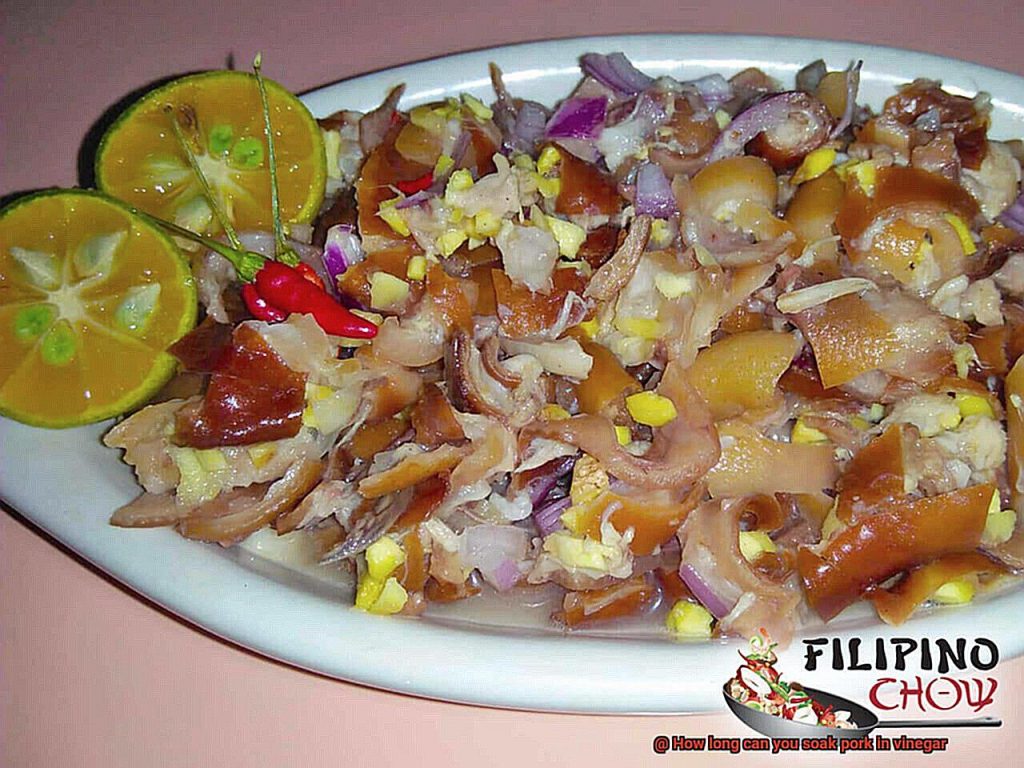Looking for a quick and easy way to spice up your pork dishes? Soaking your pork in vinegar might just be the answer you’re looking for. This tried-and-true cooking technique has been passed down through generations, and it’s an excellent way to add flavor while tenderizing your meat.
But how long should you soak your pork in vinegar? The answer isn’t as straightforward as you might think. In this blog post, we’ll take a deep dive into the world of vinegar-soaked pork. We’ll explore the benefits of this method, provide tips on how long to soak your meat, and even offer some fun variations to try out.
Whether you’re a seasoned pro or a newbie in the kitchen, we’ve got all the information you need to perfect your pork dishes. So why not give it a shot? You never know – soaking your pork in vinegar might just become your new go-to cooking method.
Contents
What Is Vinegar and What Does It Do?
Vinegar is a culinary and household staple that has been around for centuries. This sour-tasting liquid is made through the fermentation of ethanol or other sugars and comes in a variety of types, including white vinegar, apple cider vinegar, red wine vinegar, and balsamic vinegar. But what makes vinegar so special and what can it do?
Culinary Uses
Vinegar is a popular ingredient in cooking due to its acidic nature. Its pH level of around 2-3 can break down proteins and tenderize meat, making it an excellent marinade for tougher cuts of meat such as pork, beef, and chicken. Different types of vinegar provide different flavor profiles and may require different soaking times. For example, white vinegar is commonly used for marinades and tenderizing, while apple cider or balsamic vinegar may provide a different taste.
Preservative Properties
The acidity in vinegar also acts as a natural preservative by inhibiting the growth of bacteria and other harmful microorganisms. This is why it has been used for centuries to preserve foods such as pickles, fruits, and vegetables. Additionally, vinegar can be used as a natural cleaning agent due to its antibacterial properties.
Health Benefits
Apart from its culinary and household uses, vinegar has numerous health benefits. It can be used as a natural remedy for various ailments such as sore throat, indigestion, and headaches. Apple cider vinegar, in particular, is commonly used for weight loss and digestion issues due to its high acetic acid content. Some people even use vinegar as a beauty product to improve the condition of their hair and skin.
How Long to Soak Pork in Vinegar for Marinating
Look no further than marinating your pork in vinegar. But how long should you soak your pork for the best flavor and texture? As an expert on the topic, I’m here to share some insider tips and tricks.
Let’s start with the basics. Vinegar is a powerful ingredient that can add a zing of flavor and tenderize meat. The length of time you soak your pork in vinegar can make all the difference in achieving your desired outcome.
For a mild flavor and tenderizing effect, it’s recommended to soak your pork for at least 30 minutes to an hour. But if you want a more pronounced vinegar taste and even more tender meat, don’t be afraid to let it soak for up to 24 hours.
But wait, there’s more. Different types of vinegar can impact the marinating time as well. For example, white vinegar has a stronger taste than apple cider vinegar, so you may need to soak your pork longer if using white vinegar.
When marinating your pork in vinegar, be sure to use a non-reactive container such as glass or ceramic to avoid any unwanted reactions with metal. And don’t forget to cover your container with plastic wrap or a lid to prevent contamination and allow the marinade to fully penetrate the meat.
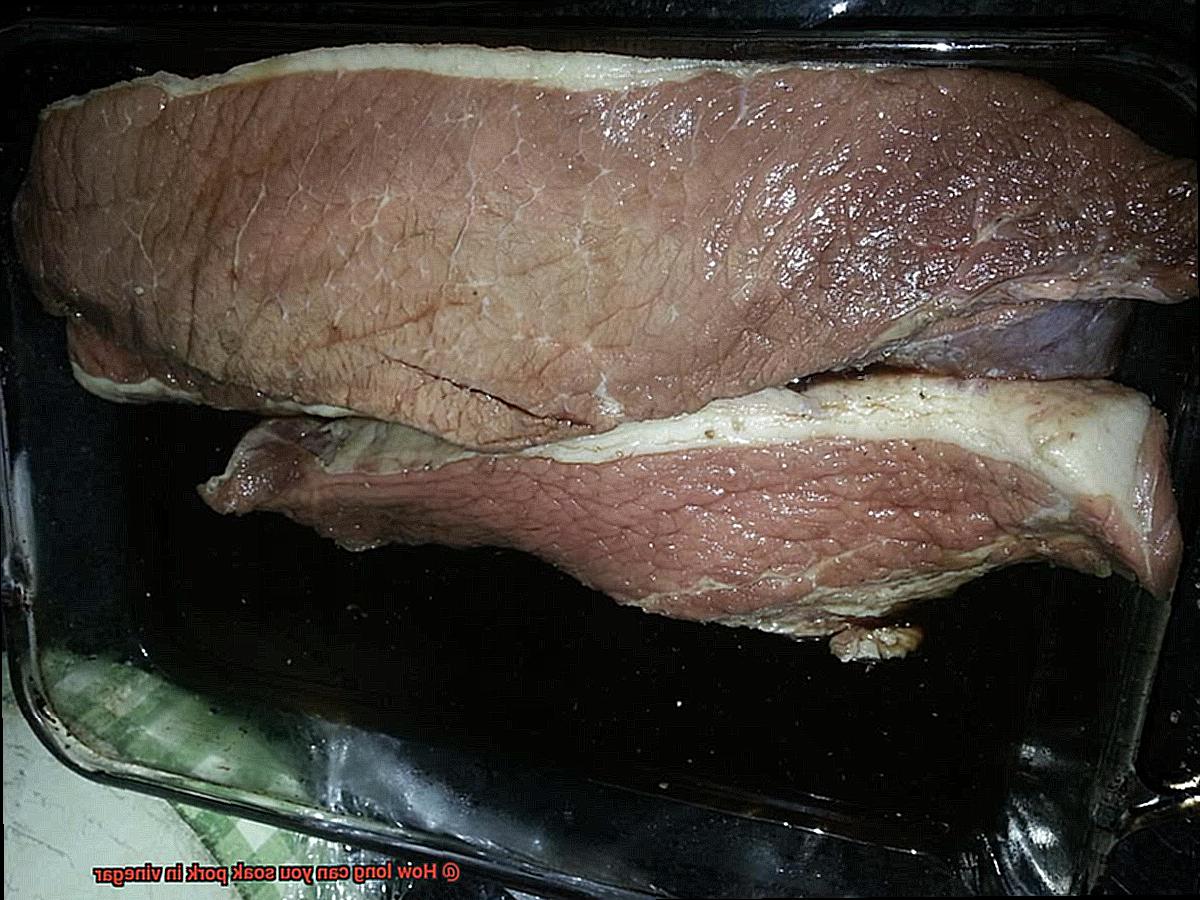
How Long to Soak Pork in Vinegar for Tenderizing
Fear not, because the secret to tender and flavorful pork is right at your fingertips – vinegar. Vinegar is a powerful tool in tenderizing meat and adding a delicious tangy flavor to your dishes. But how long should you soak your pork in vinegar for the best results? Let’s dive in.
The answer is not as straightforward as a one-size-fits-all approach. There are several factors to consider before deciding on the soaking time. Firstly, the type of vinegar you choose will impact the marinating time. While white vinegar is the most common choice for tenderizing meat, apple cider vinegar, red wine vinegar, and balsamic vinegar can also be used. Each of these vinegars has a slightly different acidity level, which will affect how long it takes to break down the tough fibers in your pork.
Secondly, the cut of pork you are using will also play a role in the soaking time. For example, a tenderloin will require less marinating time compared to a tougher cut like shoulder or leg.
In general, I recommend soaking your pork in vinegar for at least 30 minutes to an hour to achieve mild tenderness and flavor. If you want an even more tender result, you can increase the soaking time to several hours or even overnight. However, keep in mind that the longer your pork soaks in vinegar, the stronger the vinegar flavor will be in the final dish.
When it comes to choosing a container for marinating your pork in vinegar, it’s important to choose a non-reactive material like glass or ceramic to avoid contamination. Cover it with plastic wrap or a lid and let it soak away for your desired amount of time.
To summarize, here are some key takeaways:
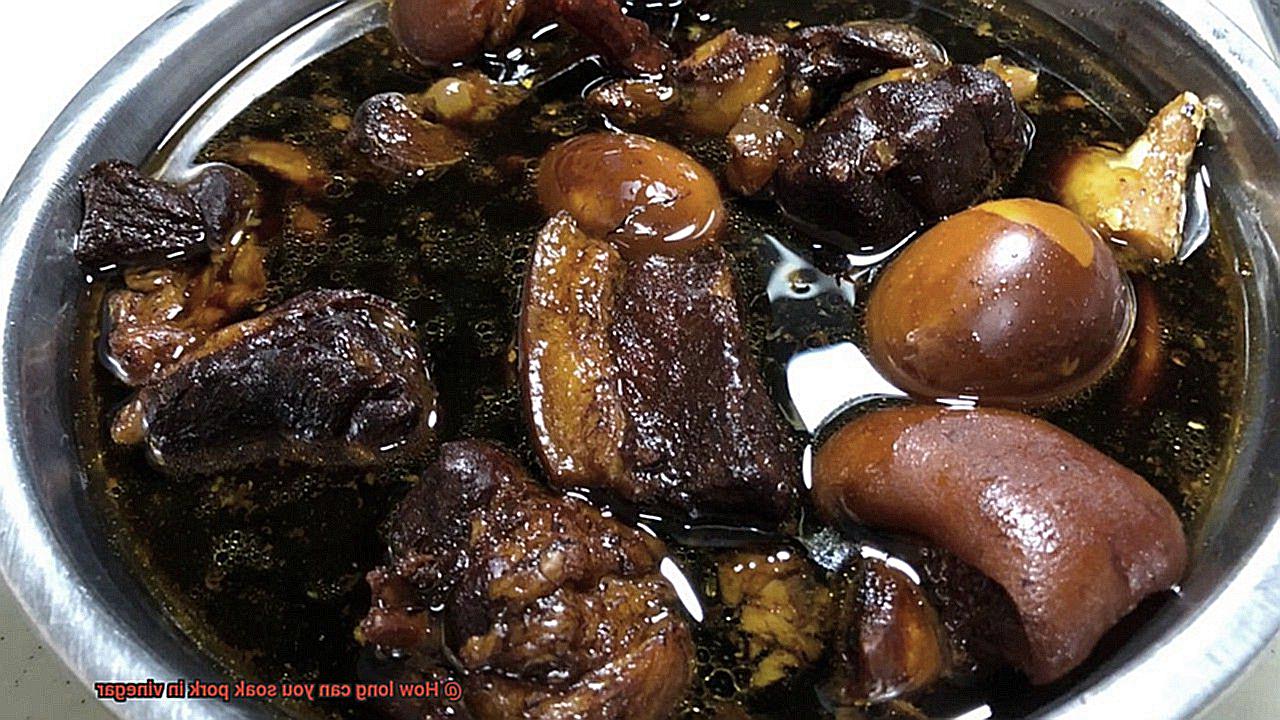
- Choose your vinegar wisely – each type has a different acidity level that affects marinating time
- Consider the cut of pork – tougher cuts will require longer soaking times
- Aim for at least 30 minutes to an hour of soaking time for mild tenderness and flavor
- Experiment with longer soaking times for even more tender results, but be aware of the stronger vinegar flavor in the final dish
- Use a non-reactive container and cover it with plastic wrap or a lid while marinating.

Different Types of Vinegars and Their Uses
Soaking pork in vinegar is a popular cooking method that can add flavor and make it more tender. However, not all vinegars are created equal, and it’s important to understand the different types of vinegars and their uses when it comes to soaking pork. Here are five sub-sections that explain the different types of vinegars and their uses for soaking pork.
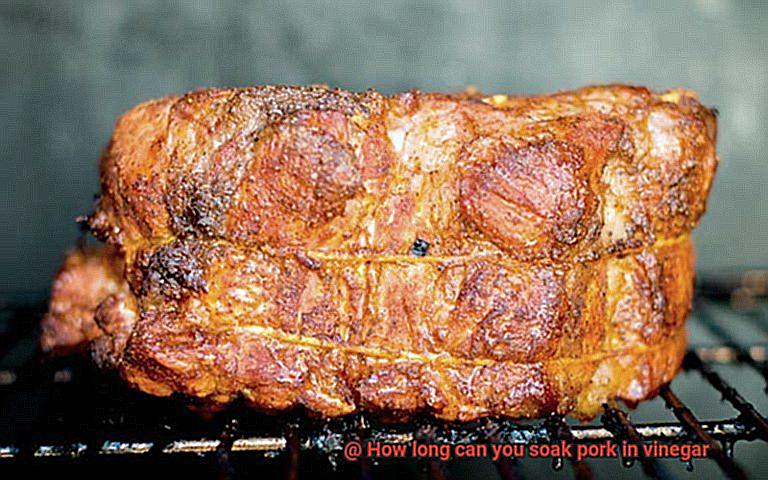
Apple Cider Vinegar
One of the most commonly used vinegars for soaking pork is apple cider vinegar. It has a slightly sweet and fruity flavor that makes it an ideal choice for marinades and sauces. Its moderate acidity level can help tenderize meat, making it a popular choice for tougher cuts of pork. Soaking pork in apple cider vinegar for a few hours can infuse it with flavor and make it more tender.
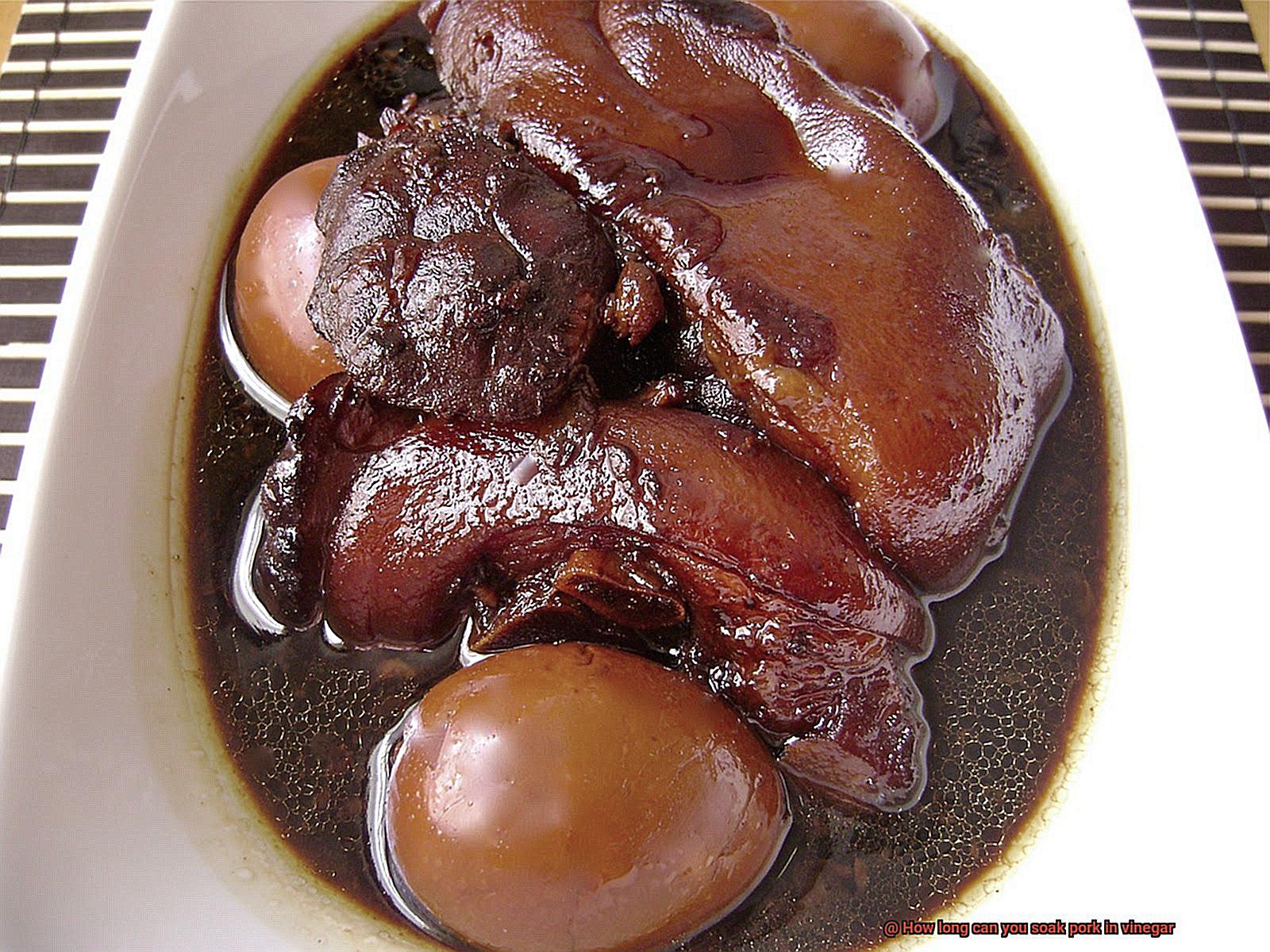
White Vinegar
White vinegar is another popular option for soaking pork. It has a strong, sharp flavor and a high acidity level that can quickly break down proteins in meat. While it’s not typically used on its own as a marinade, it can be combined with other ingredients to create flavorful sauces and dressings. Soaking pork in white vinegar for a few hours can add some tanginess to your dish.
Red Wine Vinegar
Red wine vinegar has a bold, tangy flavor that pairs well with rich, savory dishes. It also has a moderate acidity level that can help tenderize meat without overpowering its natural flavors. Soaking pork in red wine vinegar for a few hours can add depth to your dish.
Balsamic Vinegar
Balsamic vinegar is a dark, rich vinegar that originates from Italy. It has a sweet and tangy flavor with a low to medium acidity level. Balsamic vinegar is commonly used in salad dressings, marinades, and as a drizzle over grilled meats. Soaking pork in balsamic vinegar for a few hours can add some sweetness to your dish.
Rice Vinegar
Rice vinegar is a mild vinegar that is commonly used in Asian cuisine. It has a subtle sweetness with a low acidity level and is often used in sushi rice, stir-fries, and marinades. Soaking pork in rice vinegar for a few hours can add some Asian-inspired flavor to your dish.
Tips for Soaking Pork in Vinegar
Soaking pork in vinegar is a popular method to add flavor and tenderness to your meat. However, there are certain tips and tricks to follow to ensure the best results. Here are five sub-sections that can help you get the most out of soaking pork in vinegar:

Choose the Right Type of Vinegar
Choosing the right type of vinegar is crucial for achieving optimal results. While white distilled vinegar is the most commonly recommended type for pork soaking, apple cider vinegar is also a great option due to its mild flavor and health benefits. Avoid using strong vinegars, such as balsamic or red wine vinegar, as they can overpower the flavor of the meat.
Season Your Meat
Before soaking your pork, it’s important to season it with your favorite herbs and spices to enhance its flavor. You can use a dry rub or a marinade to infuse flavor into the meat.
Mix Up Your Vinegar Solution
To make your vinegar solution, combine equal parts vinegar and water in a large bowl or container. You can also add other ingredients such as garlic, onion, or soy sauce for added flavor. Be sure to mix the solution well before adding the meat.
Soak for the Right Amount of Time
The length of time you soak your pork in vinegar depends on personal preference and the recipe you’re using. Soaking for too long can lead to an overly acidic taste and tough texture. As a general rule of thumb, aim to soak your pork for no more than 24 hours and check the meat every few hours to see if it’s reached your desired tenderness.
Use a Food-Safe Container
When soaking pork in vinegar, it’s important to do so in a food-safe container. Avoid using metal containers as the acid in the vinegar could react with the metal and create an off-flavor. Instead, opt for glass or plastic containers that won’t react with the vinegar.
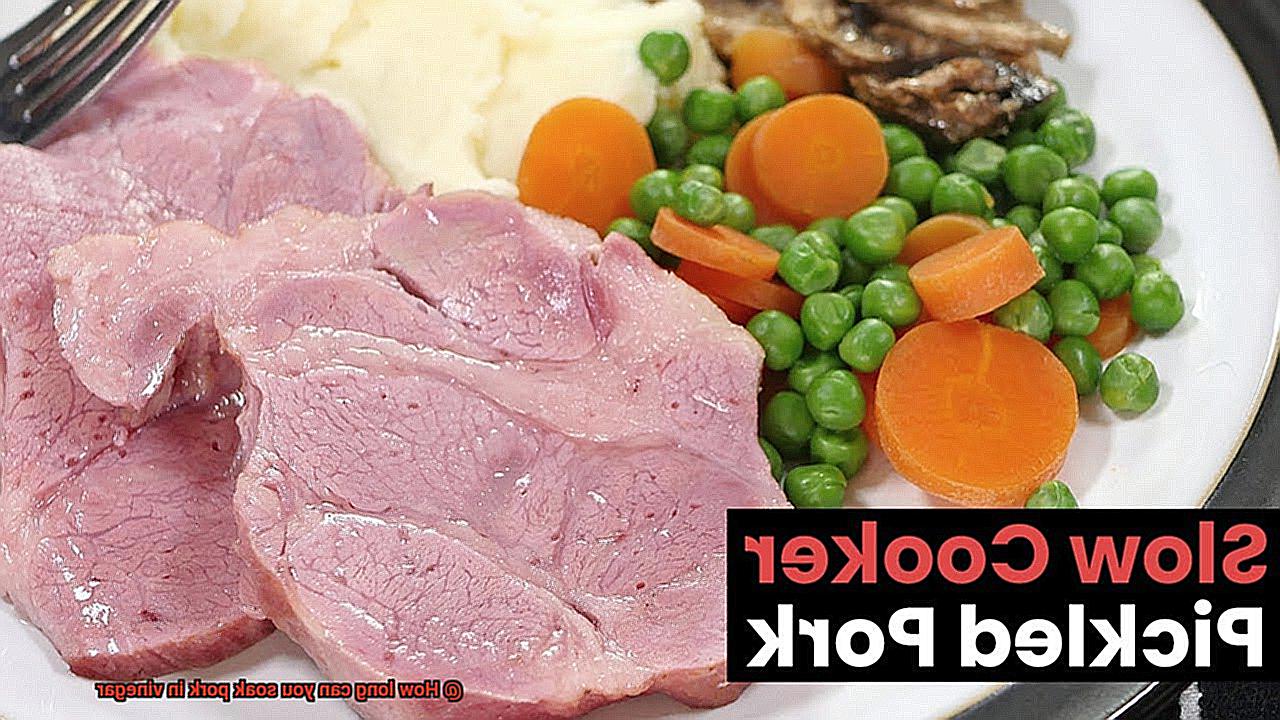
Benefits of Soaking Pork in Vinegar
The solution is simple: soak your pork in vinegar. This time-honored technique has been used by generations of cooks to tenderize meat and enhance its taste. As an expert on the benefits of soaking pork in vinegar, let me guide you through why it’s worth trying.
Firstly, soaking pork in vinegar can transform even the most stubborn cuts into a mouthwatering delight. The acidity in vinegar breaks down the tough fibers in the meat, resulting in a succulent and juicy dish. And here’s a double benefit: it also reduces cooking time, preventing the meat from becoming dry or overcooked.
But what about flavor? Vinegar’s slightly acidic taste pairs perfectly with pork’s natural flavor. When combined with marinades or seasonings, it enhances their flavors and creates a delicious meal that will leave your guests begging for seconds.

And there’s more: soaking pork in vinegar can help to kill harmful bacteria that lurk on raw meat. Acetic acid found in vinegar is known to be effective against pathogens like E. coli and Salmonella, making your meal not only delicious but also safe to eat.
To get started with soaking pork in vinegar, follow these five tips: choose the right type of vinegar (apple cider vinegar is a popular choice), season your meat with salt, pepper, or other spices, mix up the perfect vinegar solution (one part vinegar to one part water), soak for no more than 24 hours, and use a food-safe container.
Potential Drawbacks of Soaking Pork in Vinegar
Look no further than a vinegar soak to enhance its tenderness and taste. But before you dive into this traditional cooking technique, it’s essential to understand the potential drawbacks.
One significant concern with soaking pork in vinegar is that it can make the meat tough and dry if left for too long. The acid in the vinegar breaks down the proteins in the meat, resulting in an unpleasant chewy texture. To avoid this, monitor your soaking time carefully and don’t over-soak.
Another issue with vinegar soak is that it may change the color of the meat, which some may find unappealing. Additionally, too much liquid absorption can dilute the meat’s flavor, resulting in a bland taste.
Over-acidification is another potential problem when soaking pork in vinegar for an extended period. When there’s too much acid, it breaks down too much of the meat’s protein, causing a sour taste that can be overwhelming. Soaking time should be monitored closely to avoid this.
Finally, individuals with sensitive stomachs or acid reflux should steer clear of pork soaked in vinegar. The high acidity levels can exacerbate their symptoms. It’s essential to consult with a doctor before consuming acidic foods if you have any concerns.
Conclusion
To sum it up, soaking pork in vinegar is a traditional cooking technique that has stood the test of time. The acidity in vinegar can work wonders on tougher cuts of pork by breaking down proteins and making them more tender. However, the duration of your soak depends on your preference and recipe.
For a mild flavor and tenderizing effect, it’s best to soak your pork for at least 30 minutes to an hour. But if you want a stronger vinegar taste and even more tender meat, don’t be afraid to let it sit for up to 24 hours.
Different types of vinegars offer unique flavor profiles that may require varying soaking times. White vinegar is commonly used for marinades and tenderizing, while apple cider or balsamic vinegar can provide different tastes. It’s crucial to select the right type of vinegar to achieve optimal results.
Soaking pork in vinegar not only enhances its tenderness and taste but also has health benefits. Vinegar’s acidity can eliminate harmful bacteria present in raw meat, ensuring that your meal is not only delicious but also safe to eat.
Nonetheless, there are potential downsides to soaking pork in vinegar. Over-soaking can result in tough and dry meat, alter its color or dilute its flavor profile. Additionally, over-acidification can lead to an overwhelming sour taste that may not suit everyone’s palate. If you have any concerns about consuming acidic foods due to acid reflux or sensitive stomachs, consult with a doctor beforehand.
Overall, soaking pork in vinegar is an easy way to add some tangy flavor while tenderizing your meat and spicing up your dishes. With these tips and tricks at hand, why not give it a try?

